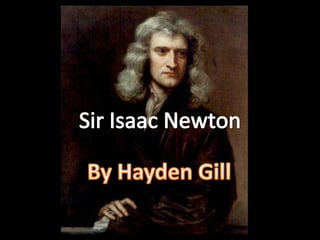
Isaac newton
- 2. Sir Isaac Newton is regarded to be one of the most influential scientists of all time. He studied physics and created the three laws of motion. This PowerPoint will tell you more about Sir Isaac Newton: He was……… Born: December 25, 1642, Woolsthorpe, United Kingdom Died: March 20, 1727, Kensington, United Kingdom Full name: Sir Isaac Newton Education: Trinity College, Cambridge (1667–1668). Parents: Isaac Newton Sr., Hannah Ayscough
- 3. Isaac Newton studied in Cambridge and he was a professor there from 1669 to 1701. His most important discoveries were made during 1664 to 1666 when the university closed and he retired from his job and returned to his hometown. From there he discovered the law of gravity from the apple story. He also discovered that white light is made of all the colours of the rainbow. These things have made him able to make contributions to mathematics, astronomy and physics.
- 4. An object at rest will remain at rest unless acted on by an unbalanced force. An object in motion continues in motion with the same speed and in the same direction unless acted upon by an unbalanced force. This law is often called "the law of inertia". -Isaac Newton It means: This means that there is a natural tendency of objects to keep on doing what they're doing. All objects resist changes in their state of motion. In the absence of an unbalanced force, an object in motion will maintain this state of motion. This law is the same reason why you should always wear your seatbelt.
- 5. Acceleration is made when a force acts on a mass. The greater the mass (of the object being accelerated) the greater the amount of force needed (to accelerate the object). -Isaac Newton This means: Everyone knows that heavier objects require more force to move the same distance as lighter objects. The Second Law gives the exact relationship between force, mass, and acceleration. It can be also told as a sum like this: Force = Mass times acceleration
- 6. For every action there is an equal and opposite re- action. -Isaac Newton This means that for every force there is a reaction force that is equal in size, but opposite in direction. That is to say that whenever an object pushes another object it gets pushed back in the opposite direction equally hard.
- 7. • Isaac was born in England, and was a physicist, astronomer, mathematician, philosopher, alchemist and theologian. • In 1687, Newton published Philosophae Naturalis Principia Mathematica, which is one of the most important books in the history of science. In it Newton describes gravitation and the three laws of motion. • Newton’s law of gravitation describes the gravitational attraction with bodies with mass.. • Newton moved to London in 1696 and took up a job as the Warden of the Royal Mint. • Newton is known to have said that his work on the theory of gravitation was made by watching an apple fall from a tree. This story is still popular today.